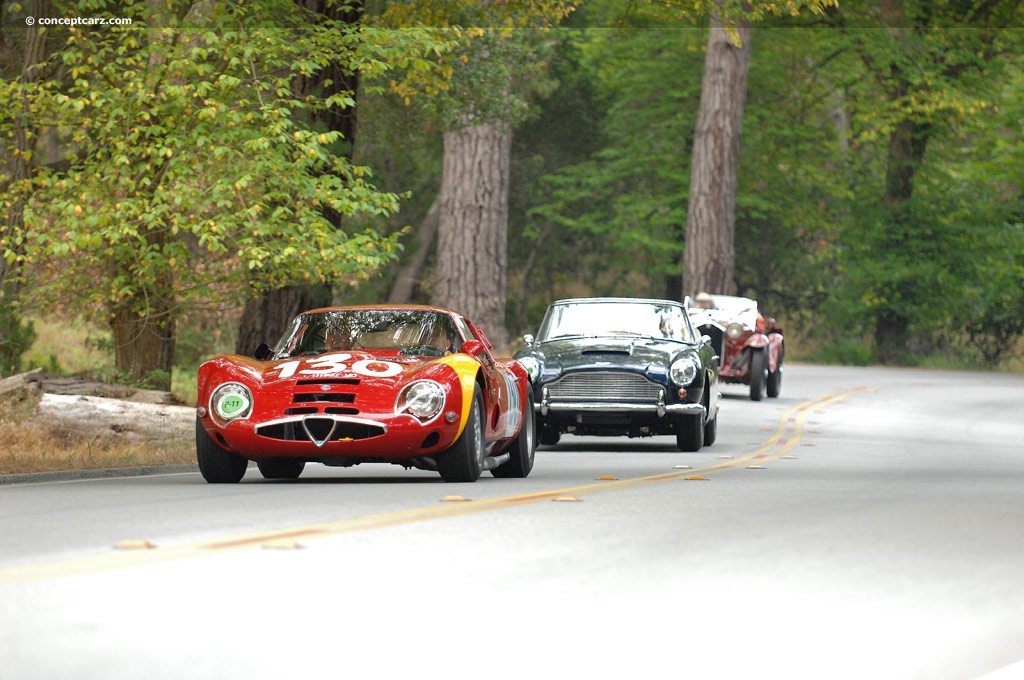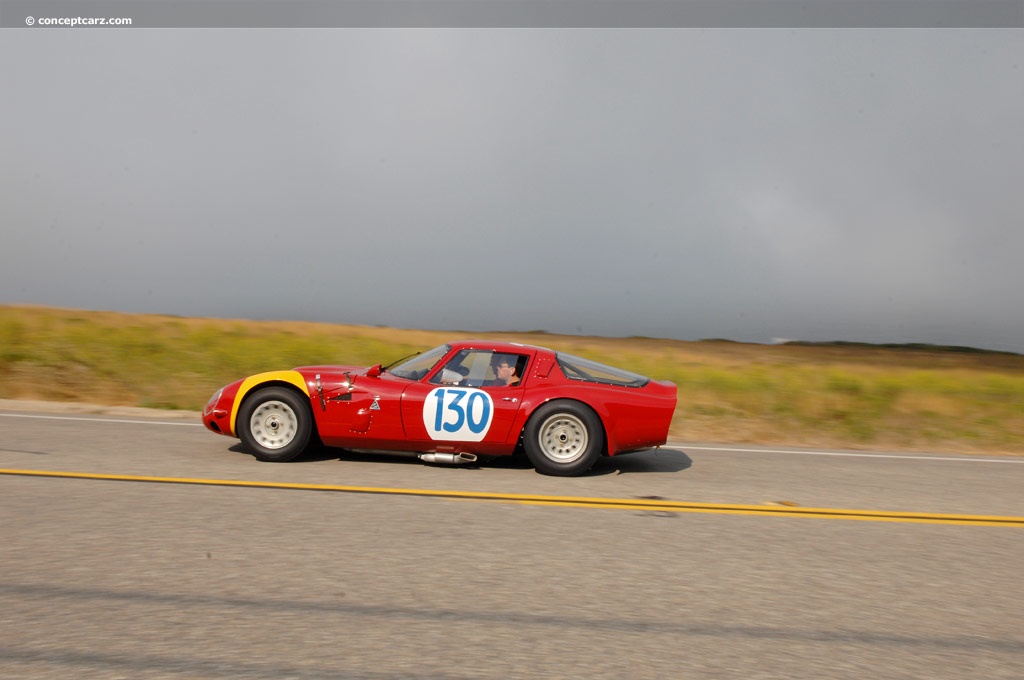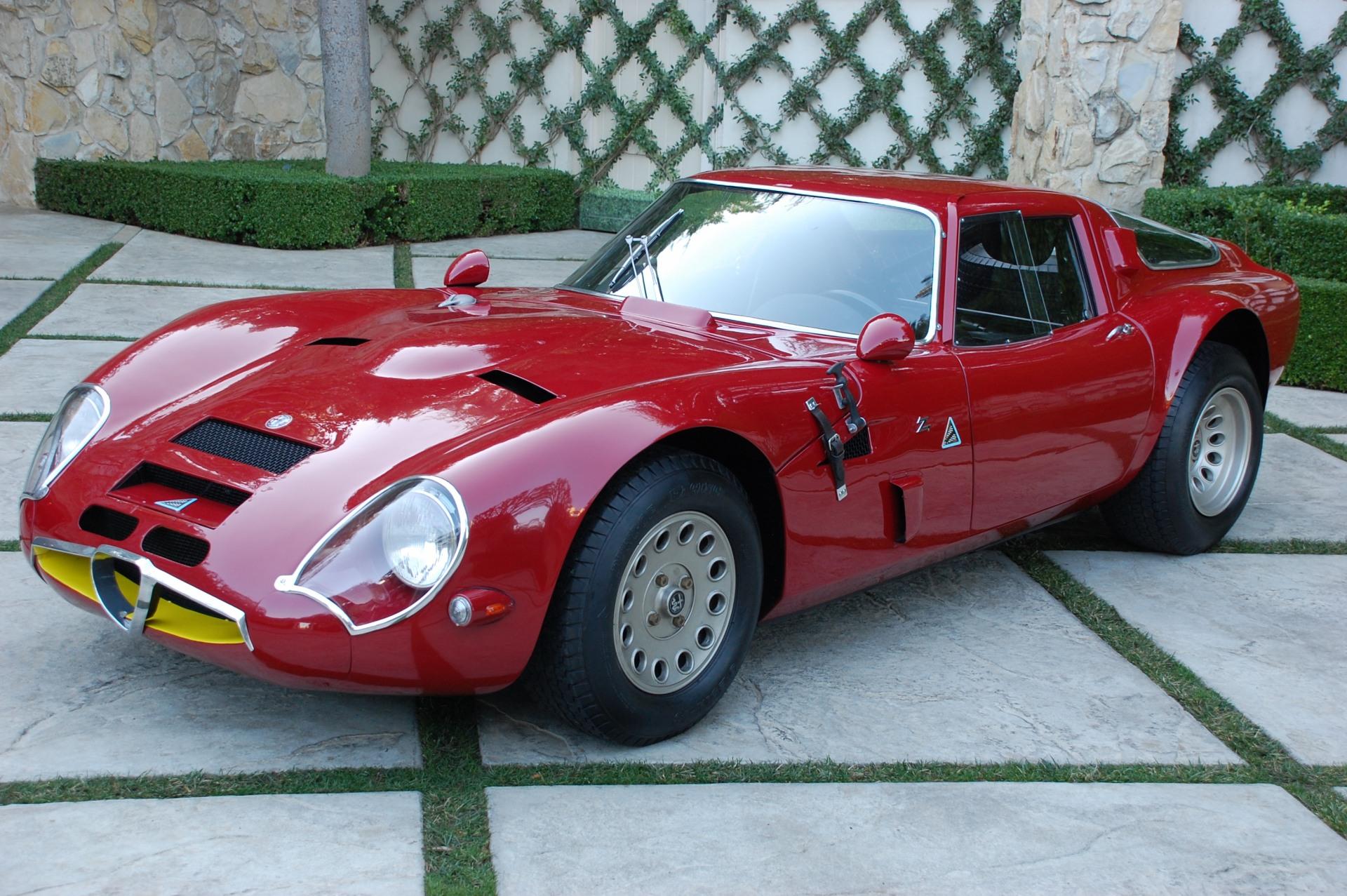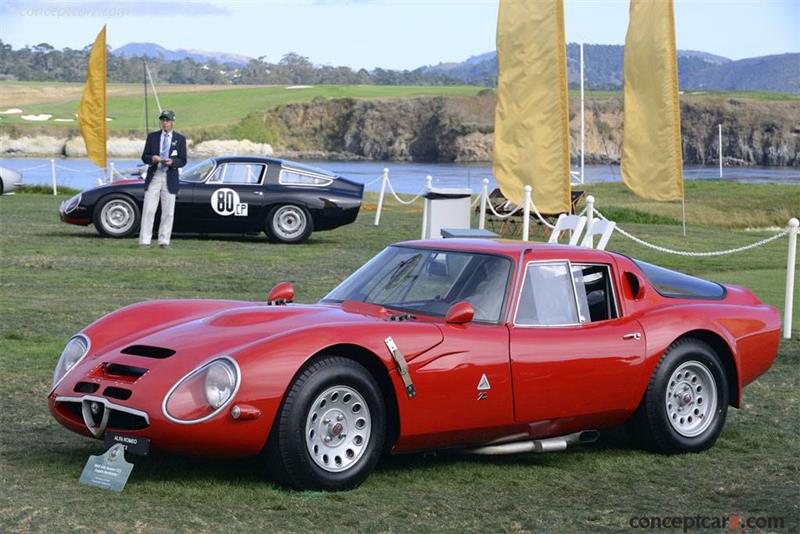Shortly after the arrival of the Alfa Romeo Giulietta in 1955, more highly developed versions followed. The first of these was the Sprint Speciale (SS) presented in 1957, with its Franco Scaglione (of Bertone) design inspired by the 'BAT' cars. Its slippery design and favorable aerodynamics enhanced the vehicle's sporty characteristics, but much more was needed for any serious racing endeavors. The next evolution was the lightened Giulietta Sprint Zagato (SZ) with a tighter form that was presented at the Geneva Motor Show in 1960.
Competition Berlinetta by Zagato
Chassis #: AR750106
View info and historyZagato gave the two-seater Berlinetta a lightweight aluminum body atop the Sprint Speciale platform. Power was via a 1.3-liter engine that used double twin-choke carburetors and a high compression ratio to develop 100 horsepower. Approximately 18 Veloces were rebodied, dubbed the SVZ, and were about 260 lbs lighter and their engine produced 116 horsepower. Alfa Romeo's first successful post-war model was the 1900, but it was the 1.3-liter Giulietta model that followed which established the 'small car, big performance' formula that would characterize the Milanese marque's finest offerings going forwards. With demand outstripping supply, Alfa Romeo was forced to rethink its production strategy and embrace, for the first time, its fate as a high-volume manufacturer. Initially offered as a Sprint Coupe, it was soon joined by Berlina and Spider versions. The highly successful Giulietta was replaced by the Giulia range, launched at the Monza Autodrome on 27th June 1962. It was the creation of a design team headed by one of the greatest Italian automobile engineers, Dr. Orazio Satta Puliga, who had been responsible for all the post-war Alfa Romeos. An increase in displacement was rewarded with a boost in power from Alfa's classic twin-cam four, from 80 to 92 bhp. The larger engine was noticeably smoother, less fussy, and more reliable. A five-speed gearbox was standard on the Giulia 1600 Spider, which remained in production until replaced by the Duetto in 1966.
Competition Berlinetta by Zagato
Chassis #: AR750106
View info and historyEnhancing the performance of the Giulia continued through various experimentation, again focusing on lightweight construction and wind-cheating designs. The SS (Sprint Speciale) adopted the 1600 engine in 1963 which boosted performance but the potential for development was too limited for it to lead the way in competition. The replacement for the Giulietta Sprint Zagato racing Berlinetta, to be built on the new 105 Series platform, was curated by the engineers at Delta, Carlo Chiti's competition concern (soon to be renamed as Autodelta). The resulting Tubolare Zagato, or TZ, first debuted to the public in late 1962 at the Turin Salon. The vehicle's name was inspired by its rigid but lightweight tube frame. Its new coachwork, created by Zagato, was formed from aluminum and molded into an aerodynamic shape that would exploit the platform's raw potential. Extensive modifications were made to the standard 105 Series running gear, including a taller fifth gear, limited-slip differential, stiffer springing and a fully independent rear suspension, and inboard rear disc brakes. The 1,570-cubic centimeter Giulia engine was mounted at a 20-degree angle that required specially cast components, including the intake manifold and the sump. Breathing through Weber carburetors, the motor developed 112 horsepower in street specification and upwards of 170 horsepower in racing guise. A top speed of 215 km/h was achievable thanks to its low weight of just 660 kilograms. 
Competition Berlinetta by Zagato
Chassis #: AR750106
View info and historyOne of the earliest examples was piloted by Lorenzo Bandini to a class win and 2nd overall finish during the model's racing debut at the Coppa FISA at Monza in November 1963. This was the first of many class victories for the TZ. During 1964, it placed first in class at the 12 Hours of Sebring, the Targa Florio, the Nürburgring 1000 KM, the 24 Hours of Le Mans, the Tour de France, the Coupe des Alpes, the Tour de Corse, and the Critérium des Cévennes.A total of 112 examples of the TZ (sometimes referenced as TZ1 to differ from later TZ2) were produced through 1965. The Giulia TZ2 was introduced in 1964 at the Turin Auto Show standing atop the Zagato stand. It was an even lighter and more powerful version of the TZ, with the light alloy body of the TZ replaced by an even more streamlined fiberglass body moulded to the chassis. The styling was faithful to its predecessor's design with one of the noticeable differences being the rear window, which was now a single unit rather than the three-part window in the TZ. Weight was reduced to 620 kg and the Autodelta-prepared twin plug, dry sump lubrication engine was tuned to 170 bhp at 7,000 RPM. The top speed increased by approximately 30 km/h, to 245 km/h. Production of these purpose-built race cars was exclusive, with just 12 units being built through the end of 1965 before Alfa Romeo shifted its attention to the new GTA racing program.The Alfa Romeo TZ2 continued to expand upon the racing resume of the TZ, with a class victory on April 25th of 1965 at the 1000 km of Monza (seventh overall and first in the GT 1600 category). Additional class victories were achieved at the 12 Hours of Sebring; Bianchi-Rolland in the Targa Florio; and Adamich-'Geki' in the 1000 km of Nürburgring, the 6 Hours of Melbourne, the Giro d'Italia and the Criterium des Cevennes. The following year, class victories were achieved at Monza, Sebring, the Targa Florio, and the Nürburgring.
Competition Berlinetta by Zagato
Chassis #: AR750106
View info and historyThe three 'BAT' cars explored the purest shapes to achieve aerodynamic efficiency and the result of those studies influenced the designs of Alfa Romeo vehicles for decades to come. The perfectly executed Berlinetta designs, with their purpose dictating the form, culminated with the TZ and TZ2 competition cars that wore restrained styling communicating efficiency, from the small grille at the front to the cut-off tail at the rear. The tubular chassis (manufactured by Ambrosini), lightweight and aerodynamic bodies (Zagato), finely tuned engine, and sophisticated mechanical components (assembled by Autodelta) were rewarded with numerous class victories throughout their racing career.
by Daniel Vaughan | Sep 2022

Competition Berlinetta by Zagato
Chassis #: AR750106
View info and history

Competition Berlinetta by Zagato
Chassis #: AR750106
View info and history

Competition Berlinetta by Zagato
Chassis #: AR750106
View info and history

Competition Berlinetta by Zagato
Chassis #: AR750106
View info and history
by Daniel Vaughan | Sep 2022
Related Reading : Alfa Romeo TZ2 History
Ing. Carlo Chiti was in charge of Autodelta during the creation of the Alfa Romeo TZ2 project. His resume included being a former Chief Engineer at Ferrari. It is understandable that the inspiration and passion of the Ferrari 250 GTO bled into this project. The TZ2 (Tubolare Zagato) was constructed as a works car and there were no intentions of providing any examples to privateers. They were intended....
Continue Reading >>
Continue Reading >>
Similar Vehicles
Similarly Sized Vehicles
from 1965
Alfa Romeo Monthly Sales Volume
March 2023
2,390
1965 Alfa Romeo Giulia TZ2 Vehicle Profiles
Recent Vehicle Additions
Performance and Specification Comparison
TZ2 Specification Comparison by Year
Year
Production
Wheelbase
Engine
Prices
Related Automotive News

Gooding & Company Releases Entire Catalogue for Upcoming London Sale, Led by a 1953 Ferrari 166 MM/53 Spider Offered from Long-Term Ownership
The London Auction at Hampton Court Palace will present an unrestored Ferrari 166 MM53 Spider and Ferrari 250 Europa, as well as a desirable Fiat 8V Berlinetta and right-hand-drive Aston Martin DB5 Convertible.
Gooding %26 Company, the international...

Ex-Surtees race-winner and rare Chinetti-commissioned Spider join Salon Privé's Ferrari 75th Anniversary class
Salon Privé Concours dElégance presented by Aviva introduces pair of important Maranello models - from road and track - in its Ferrari 75th Anniversary class
#1 - One of only two Ferrari 275 GTB4 S NART Spiders built with an aluminium body, and...

Gooding & Company Proudly Presents 'Passion of a Lifetime' – A Masterpiece Collection of Sixteen Substantial Automobiles for Sale on 1 April 2020
Santa Monica, Calif. (22 January 2020) – Gooding %26 Company, the internationally recognized auction house, is honored to reveal the automobiles comprising the companys first-ever London sale, Passion of a Lifetime, at Somerset House in central...

FCA Stars In The Goodwood Festival Of Speed 2017
From 29 June to 2 July, West Sussex will host one of the most prestigious events of international motor sports – Goodwood Festival of Speed 2017. Making an appearance will be rare classic Alfa Romeo, Abarth, Lancia and Fiat cars, along with the latest...

1964 Nurburgring 1000 Kilometers: Survive for One Last Victory
During the late 1950s, Richie Ginther would begin a relationship with John von Neumann and this partnership would result in one of the most dominant periods of American sportscar racing in which Ginther and Porsche would be virtually unbeatable. Nearly...






































